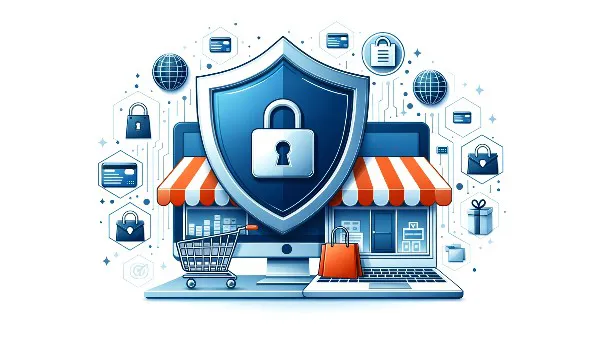Whether you own a brick-and-mortar store or run an e-commerce website, one of your priorities should be to protect your business and its customers from scams. A business that boasts robust security protocols is better positioned against the risk of financial loss, and it also appeals to more consumers. If your target audience knows for sure that you care about their safety and privacy, they won’t be afraid to shop in your store or order products from your website. This peace of mind, in turn, will boost your customer trust and loyalty.
Unfortunately, even large businesses can sometimes find it hard to deal with phishing and credit card fraud. Technology has advanced, and so have the methods of scammers who will stop at nothing to exploit business vulnerabilities. Nevertheless, even if you head a small- or medium-sized enterprise (SME) or startup, don’t be remiss in protecting both your assets and your customers from the taint of financial crime. Here are five safety and security strategies to help you avoid phishing and credit card fraud, and to shield your business from incidents of theft and deception:
1) Secure Your In-Store POS Terminal and Online Payment Gateway
To maintain the trust of your customers, it’s imperative that you secure the payment processing system used in your stores. Your customers will only be able to rest easy if they know that their financial information is being handled securely. Integrating secure and reliable payment processing technologies into your business will reduce the likelihood of crime happening at the point of sale and enforce customers’ belief in the integrity of your system.
If you own a brick-and-mortar store, you’ll want to invest in a point-of-sale (POS) terminal that complies with the Payment Card Industry Data Security Standard (PCI-DSS) and is ATEX- and EMV-certified. These certifications ensure that the device has undergone rigorous testing to pass stringent security requirements for handling payment card data. The Maya business terminal, from leading fintech company Maya Business, is one good example.
The Maya terminal is designed to accept various modes of payment, from debit and credit cards to QR code and mobile wallet payments. As such, it’s built to provide users with a safe and secure payment process experience. With the Maya POS terminal, you and your customers can be assured of top-notch security over payment data every time a transaction is completed in your store.
Online businesses should secure their payment gateways by obtaining a Secure Sockets Layer (SSL) certificate for their websites. This certification makes it significantly more challenging for cybercriminals to intercept customers’ information during their transactions. Customers will be able to tell whether a website is protected by SSL if its URL starts with HTTPS. This is a fact that you can share with them to appease any anxieties they may have about buying from you.
2) Find More Ways to Protect Your Business Website
You can also strengthen the online security of your business website by installing reputable antivirus, antimalware, and firewall software on your web server. These security layers will equip you better to identify and neutralize potential threats, thus protecting your website from malware infections and warding off hacking attempts. Once they’re implemented, make it a habit to regularly update these software components to ensure that they remain effective against evolving cyber threats.
Modern phishing and fraud detection tools are also instrumental in the fight against online financial crime. These systems utilize advanced algorithms and threat intelligence to detect and block online phishing attempts and fraudulent activities. If you’re proactive about identifying and mitigating these threats, you’ll be able to demonstrate your dedication to providing a secure online shopping experience for your customers. This is something that will compel them to choose your business over those of your competitors.
3) Implement Advanced Security Features and Train Your Business Staff as Your First Line of Defense
To further strengthen your business’s defense against these crimes, implement more advanced security features and procedures than the ones you may already be employing. Consider setting up two-factor authentication (2FA) protocols like one-time PINS on your website to further protect your customers’ data. Although it requires them to complete an extra step to access their accounts or complete their transactions, 2FA will ensure that the transaction is being led by a verified user.
If you’re looking to boost the security of your in-store transactions, train your staff to take extra care when validating a customer’s ID and credit card with every credit card purchase. This simple step will deter would-be fraudsters from trying anything funny and thus protect your customers from having to deal with the fallout of unauthorized transactions.
Install security cameras in key locations in your store if you haven’t done so already. Beyond deterring theft, cameras will provide your business with valuable evidence in case of fraudulent activities. It won’t be as hard to get the details of an incident and find the perpetrator.
4) Educate Your Customers and Employees on Modern-Day Scams and Fraudulent Activities
Customer and staff education remains one of the most powerful defenses against phishing and credit card fraud. Both will be better equipped to steer clear of scammers’ modi operandi if they can recognize the signs.
As such, take the time to teach your customers and employees how to identify these fraudulent activities. Provide them with practical examples of phishing emails, fake websites, and common fraud tactics so that they can easily spot them. You can do this by sending email reminders or creating infographics to post on your business’s social media accounts.
Make sure that your customers and employees understand the importance of verifying the legitimacy of any requests for personal or financial information, especially via email or phone. Keeping your team and customers informed will allow you to create a powerful collective shield against scams and fraudulent activities.
5) Create an Incident Response Plan
No security strategy is foolproof, but having a proper incident response plan can mitigate the damage wrought by financial crime and fortify a business’s future defense against it. If you and your employees know how to respond to suspected fraud and take the right steps as soon as possible, you’ll have a better chance of stopping a criminal in their tracks and preventing further breaches.
When it comes to safeguarding your business and customers from scammers and fraudsters, you need to use a multi-faceted approach. The tips above should help you stay one step ahead of scammers and fraudsters and ensure that your business is safe and trustworthy in the eyes of your customers.





